Articles Menu
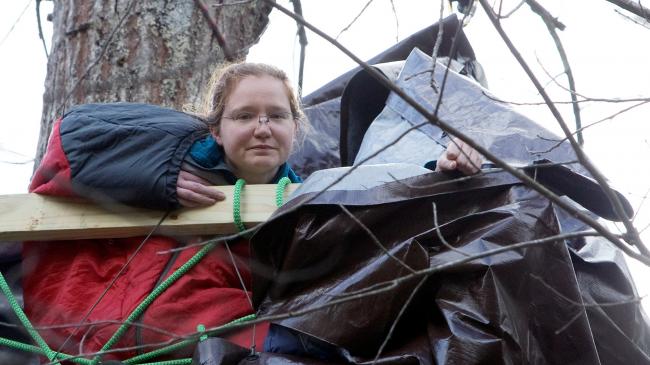
It was early springtime—ramps and redbuds showing themselves in the foothills of Appalachia, rain filling the creek beds—when our family got a notice in the mail saying that the energy conglomerate Kinder Morgan planned to repurpose the Tennessee Gas Pipeline, which runs past our house. This is the same line that, five miles from where we live, exploded in 2011, leaving a crater 30 feet across and 15 feet deep and destroying three homes. We felt the ground shake from the blast.
My family and I live in Southeast Ohio near the border of West Virginia, territory traditionally shared by the Shawnee, Seneca, and Tsalagi. Many people here, including our family, drink from springs or wells. When I was still new to the area, a friend told me, “Growing up here, we were always told, folks here might be poor, but one thing we have plenty of is good water. We can rely on the water.”
Yet Appalachian water has often been threatened. Years of coal ash dumping has tainted it with radium and arsenic. The chemical company DuPont knowingly leaked carcinogens into the water supply for decades. In 2014, Freedom Industries spilled MCHM, a chemical used to process coal, into the Elk River in West Virginia, rendering water undrinkable across nine counties. People here have seen what big industry can mean for water.
Now fracked gas pipelines are being pushed through Appalachia, not only the one near my house but also the Mountain Valley Pipeline and the Atlantic Coast Pipeline. The MVP and the ACP would originate in northwestern West Virginia and run down through Virginia, parallel to each other about 100 miles apart in routes that will take them through national forests, the Appalachian Trail, waterways, and private land. A report earlier this year from the National Resources Defense Council warned that construction of the MVP and the ACP would cause erosion and stir up sediment in drinking water sources before they were even operational.
Amy Mall, a senior policy analyst at the NRDC, told me, “Some people think erosion doesn’t sound so bad, but it’s considered a major source of water pollution. It increases turbidity, which makes it harder for plants and animals to live. Water temperature is also affected. Sedimentation can clog intakes for public water supplies. Quantity can also be impacted. Basically, these construction projects can crush an aquifer, so there’s no water available in a well anymore.” Chemical spills from the drilling process are also a risk, Mall added. After the pipelines are finished, residents will worry about explosions like the one that happened near our house in 2011, or about natural gas leaking out and contaminating their water—according to High Country News, between 2010 and 2017, 17.55 billion cubic feet of natural gas has leaked out of the country’s sprawl of pipes.
The current tree-sitters, Lauren Bowman and an activist going by the name “Nettle,” climbed to their platforms on September 4 and have been up there for more than a month. Before climbing her tree, Bowman posted a statement to the Appalachians Against Pipelines Facebook page, a group which supports MVP and ACP resistance. She wrote, “This industry has historically taken advantage of low-income and minority communities and as a result has perpetuated cyclical poverty and oppression in Appalachia and beyond… I am compelled to fight back against this pipeline because I cannot sit back and ignore what is happening to my home and to the mountains that I have known and loved since I was a child.”
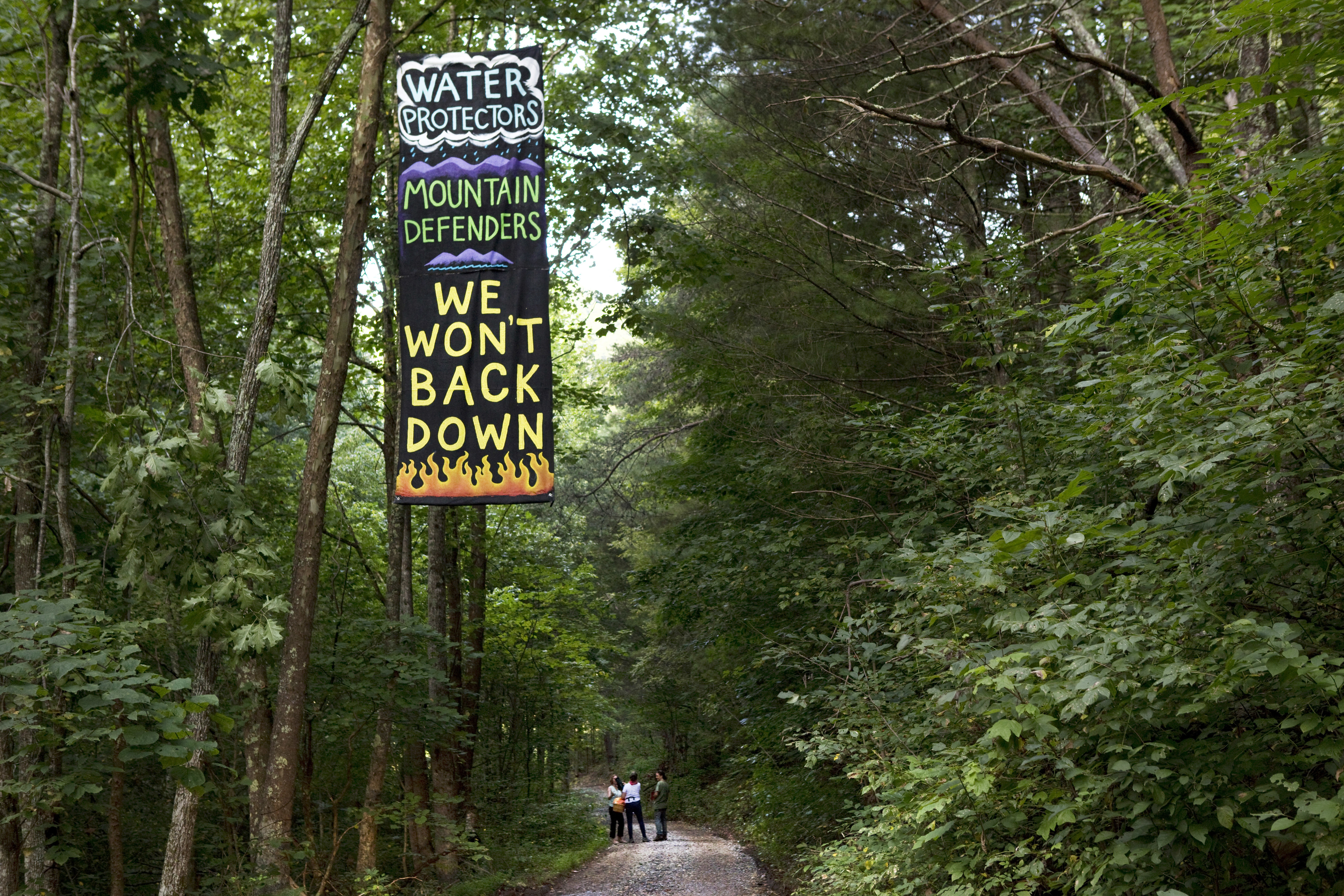
In April, my husband and I packed a tent and sleeping bags, buckled our two small children into their car seats, and drove a couple of hours east to Monroe County, West Virginia, to a base camp for the Mountain Valley Pipeline tree-sits. When we arrived, the camp was aflame with activity. Neighbors came by to drop off food and supplies, or to volunteer to hike up the mountain and camp near the tree-sit. My toddler played with a lively brindled terrier, while my four-year-old helped spread straw across a muddy driveway. Kim Kirkbride, a local farmer and organizer, told me that the tree-sits were just one tactic among many, including submitting letters and public comments, calling the governor, filing lawsuits, and monitoring MVP activities. “When the pipeline company came around, folks just didn’t buy the deal,” she said. “People have been doing everything they can to stop it.”
A few hundred feet beyond the police camp, a young West Virginian waved me towards a small tent, a tarp, and a fire ring. As he broke off pieces of energy bars to feed the baby, unearthed dry twigs, and started a smoky fire, he told me that, because we could no longer send food and water up Deckard’s tree, our job as ground support was mostly to give him a measure of safety by acting as observers.
From where we sat, I could see Deckard’s platform, a four-by-eight sheet of plywood secured with ropes to the trees surrounding it. The platform was cocooned by a black tarp, a shelter that also obscured Deckard from view. A banner flew from the tree: “Fight Back Against Frack Pipelines. Clean Water is Our Future.”
A few days later, when I reached Deckard by phone, I asked him how he spent his days. “Sleeping. Thinking. Fighting off bugs. There have been some pretty big storms,” he said. But he was more interested in telling me why he was up there. “I just couldn’t be idle anymore,” he said. “It’s approaching midnight on climate change. Investing in fossil fuels infrastructure is madness at this point. Action is imperative.”
Russell Chisholm works with the groups Mountain Valley Watch and Preserve Giles County. He moved to the region after he finished his military service over 20 years ago. “It’s a farming community with families going back several generations,” he said. “People rely on springs and wells.” The tree-sits inspire people, he said. “When someone is willing to attach themselves to a pole on top of a mountain surrounded by law enforcement for months, then we can get up every day and monitor or go to state water control board meetings.”
“Nobody wants these pipelines,” Kirkbride told me. When people refused to turn over their homes to the pipelines, the companies invoked eminent domain. Overnight, pipeline protesters like Red and Minor Terry—whose lawsuit to stop the MVP was rejected by a judge earlier this year—became trespassers on land their families have called home for generations. In Union Hill, Virginia, residents say Dominion Resources underreported the historically African American town’s population by more than 500 percent in order to expedite plans to build a compressor station there. John and Ruby Laury, along with their neighbors, are accusing the company of environmental racism. Kirkbride told me that when EQT/NextEra filed a restraining order against the tree-sitters, the circuit court judge ruled in favor of the protesters in March.
Saying that she has plenty of supplies, Bowman told one local news outlet, “I could be up here for months.”
Others are busy on the ground, fighting in the courts. On October 2, a federal court sided with the Appalachian Mountain Advocates, ruling that the original permit granted the MVP was improper. The ruling means that MVP can no longer cross rivers and streams. Because pipeline construction cannot continue unless all permits are in place, the MVP has been effectively stopped. It’s a major victory, but seasoned organizers don’t always trust such rulings. The tree-sitters remain in place for now.
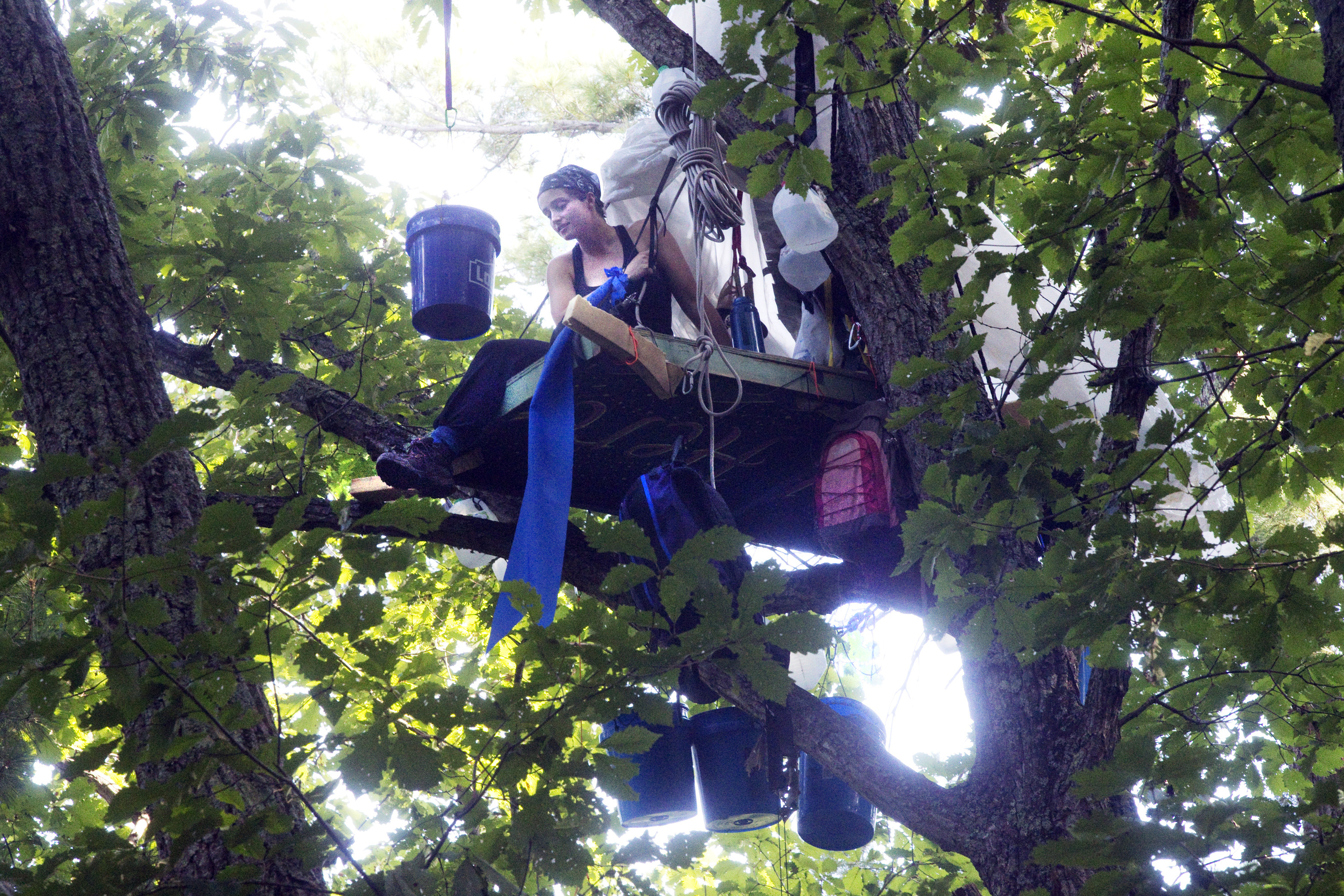
Conventional gas pipelines have been common in Appalachia since the 1950s. So why the fervor over pipelines now? “The industry wants to move more gas,” said Carl Weimer, executive director of the Pipeline Safety Trust, a group that works to reduce accidents. “The way you do that is you bump up the pressure. Conventional lines generally operated at 500 to 800 PSI, now it’s 1,400 PSI or higher.” According to Weimer, this can significantly widen the incineration zone, the area affected by a pipeline explosion. “The federal regulatory term for that is impact radius, which is much more sanitary,” Weimer said. “You have a good chance of dying within that impact radius.”
What is a pipeline company’s responsibility for fixing these problems?
“If it were you or me and we broke the law, we’d expect to get in trouble. It’s different for pipelines,” Mall, the policy analyst, said. “They may get written up. They may not. Maybe they’ll stop work for a little while and then start back up. Any action is after the fact, and doesn’t prevent it from happening again.” She told me that MVP has been cited repeatedly for inadequate sediment and erosion control. “How many violations does it take before they’re forced to stop operating?” Mall asked. “There’s no number for that.” (I reached out to Dominion Resources and EQT/NextEra, the companies behind the ACP and the MVP, but they did not respond.)
“Accidents are rare,” claims the mail we got from FERC. Mall disputes this: “Chemical spills have already happened in various states. The Mariner 2contaminated groundwater in Pennsylvania. The Rover has contaminated waterin at least three states.” Over the past four years, blasts in Pennsylvania and Kentucky have injured people and leveled buildings. Weimer mentioned the pipeline explosion that happened this June in West Virginia. On September 10, a massive explosion of an Energy Transfer Partners line in Pennsylvania caused 30 homes to be evacuated, and the local school district to cancel classes.
St. James Parish, Louisiana, is home to L’eau Est La Vie, a camp standing in the way of the Bayou Bridge pipeline, owned by Energy Transfer Partners. Cherri Foytlin, who is Din’e, Cherokee, and Latina, sits on the camp’s advisory council. “The Bayou Bridge pipeline goes through 700 bodies of water,” she told me. “That includes Bayou Lafourche, which is the drinking water source for 300,000 people, including the United Houma Nation, and many indigenous communities that have already suffered land loss. These are the first climate refugees.”
Foytlin described another way that the pipeline impacts water where she lives, one that is particularly significant in the new reality of mammoth hurricanes and extreme weather exacerbated by climate change. “ETP is killing the wetlands,” she said. “Wetlands are the creator’s natural system for soaking up water, so now we’re more affected by hurricanes and flooding.” Her own house has been flooded twice since pipeline construction began, she told me. “These pipelines remind me of someone with stage 4 cancer who just keeps smoking,” she said. “It doesn’t make sense.”
In Texas, Cindy Spoon has worked against pipelines such as the Keystone XL and the Trans-Pecos. She told me that, during an action in East Texas against the KXL, activists climbed inside a pipeline that was sitting in a pit waiting to be buried. From inside the pipe, they saw visible holes. “They took photos from inside where you can see sunlight coming through the welds,” she said. Spoon says that after police removed the protestors, the pit was immediately filled in, covering the pipeline with no further attention to the welds. “We only did one action like that. It was a totally random sample, and we saw those leaks. It can only mean that they’re more common than people think.”
Though he is currently most focused on Bayou Bridge, Tilsen also talked to me about Enbridge Line 3, which is slated to run through Minnesota and Wisconsin. It’s opposed by a large coalition, including five Ojibwe tribal governments. Tilsen believes that organizers have learned a lot since the fight against DAPL. “At Standing Rock, we saw our culture and spirituality bring us together. But we also saw our most colonized relatives use our spirituality to control us and keep us from fighting the pipeline. I don’t think any native resister will let those mistakes happen again.” He predicts that the fight against Line 3 will more directly intervene against construction, pointing to the statement released in June by the Ojibwe Warrior Society, which reads, in part, “This is not Standing Rock and we will not be infiltrated and peace policed while a pipeline is forced upon us.”
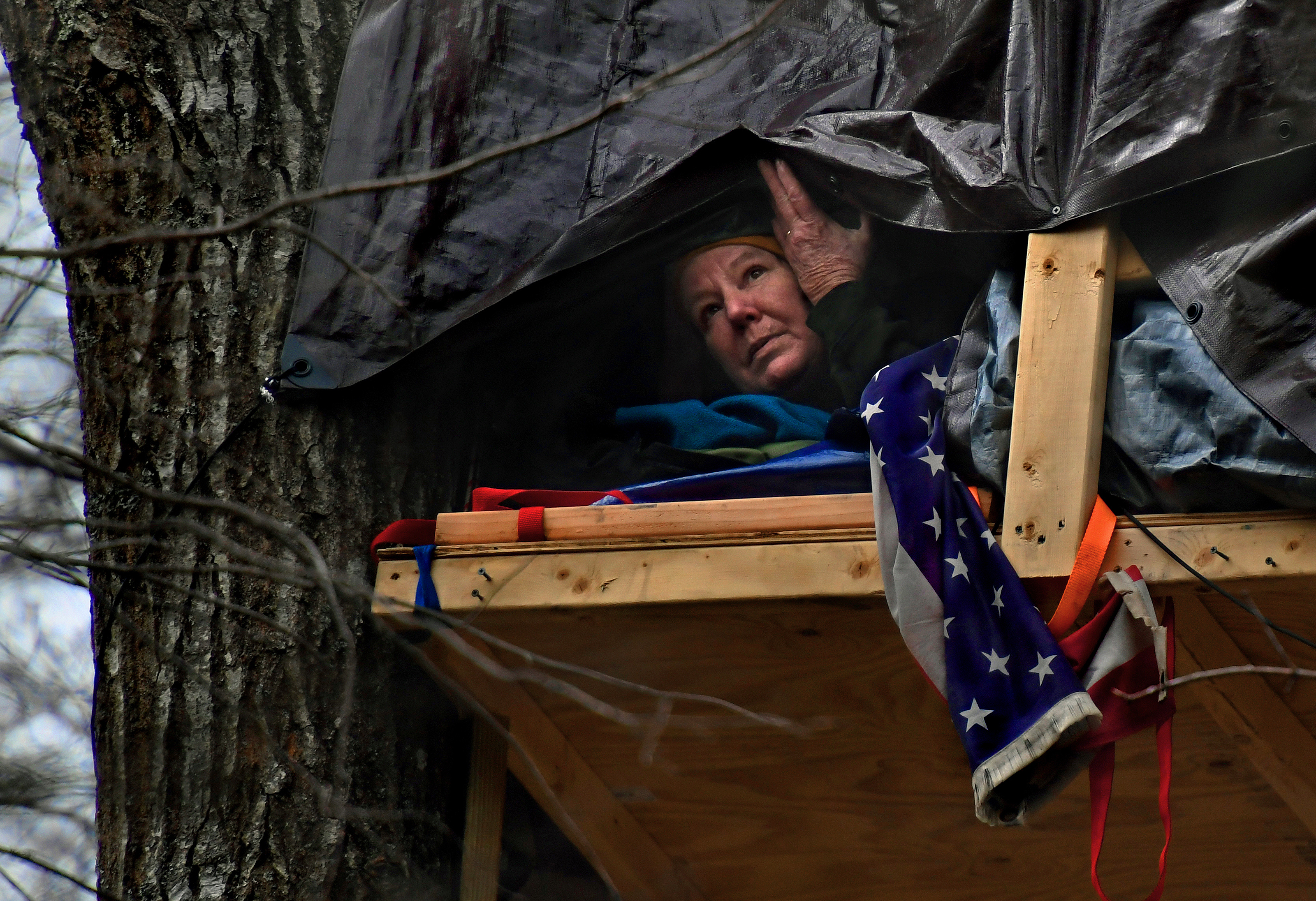
In July, L’eau Est La Vie issued a broad call to action against pipeline companies and their financiers, labeled #risetogether. By mid-July, three new tree-sits had gone up in the path of the Bayou Bridge Pipeline. Since then, new actions have been launched in Louisiana almost daily. Reprisals from law enforcement and company security have grown increasingly violent, and water protectors are facing potentially steep charges due to newly passed laws criminalizing protests near “critical infrastructure.” Yet rather than discouraging resistance efforts, such repression is having the opposite effect. The ranks at L’eau Est La Vie have swelled. The camp’s most recent call to action, #strikedownETP, was set for September 18. Several solidarity actions happened that day, including one in Bemidji, Minnesota, where indigenous organizers raised a tipi blockade and conducted a water ceremony that temporarily halted construction of Line 3.
But solidarity is complicated. In Appalachia, landowner rights have been an anti-pipeline rallying cry, as people push back against the government taking their homes through eminent domain. Many indigenous organizers, for whom pipeline resistance is also a stand against colonization, object to that rhetoric. Tilsen said, “We all have an understanding that pipelines destroy the land and contaminate the water. We can build relationships. But we have to begin with the understanding that this is indigenous land.”
“We’re indigenous people and we don’t mind reminding people whose land they’re on,” Foytlin added. “We also don’t mind uniting against these pipelines.” She said that at L’eau Est La Vie, “We don’t call people landowners. We’re looking more at their humanity and less at their possession. We call them neighbors.”
Chisholm thinks Appalachian views are changing. “We may have started out like, Shit, I got to protect my well,” he said. “But now we’re making connections about climate change and the way these companies go after anybody they think has less resources to fight back. We’re starting to see the bigger picture.”
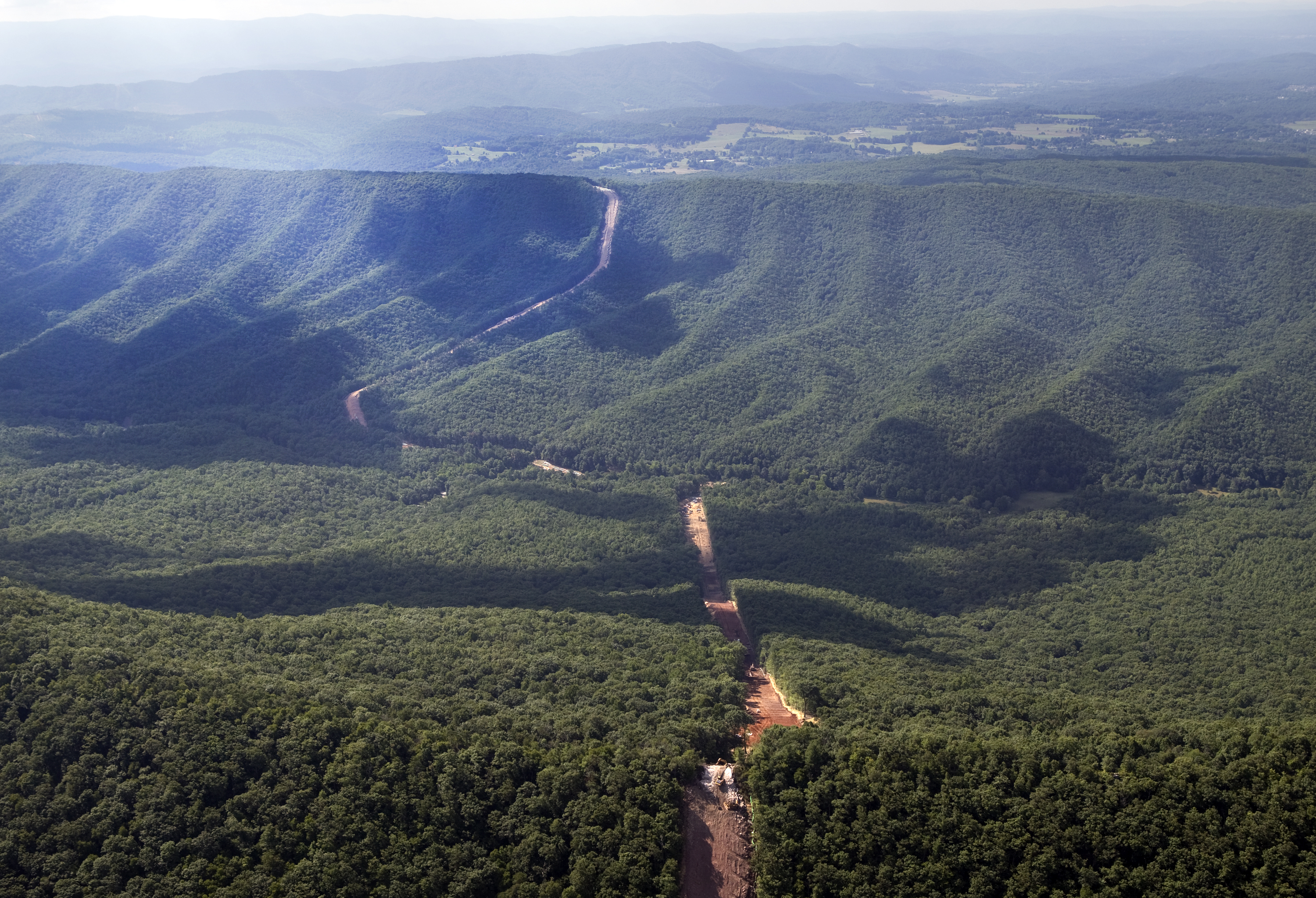
The most famous pipeline resistance fight in recent history, the one against the Dakota Access Pipeline, did not end well—the Obama administration blocked construction, but the Trump administration reversed that decision, and the tribes have subsequently launched a court challenge against the pipeline. Water protectors are still facing legal battles.
Spoon directed me to a list of pipelines that have been stopped by popular resistance. “Look up the Energy East Line,” she said, referring to a pipeline that would have delivered diluted bitumen from the Northwestern United States to eastern Canada. “It was going to be even larger than the Keystone XL. Because of grassroots resistance, mostly indigenous-led, TransCanada decided that the financial benefit wasn’t worth it. They scrapped the project. The industry needs to know that every community they face will be against them.” In August, Kinder Morgan’s Trans Mountain pipeline was halted after a federal court of appeals in Canada ruled that First Nations hadn’t been properly consulted.
Tilsen said, “Sun Tzu says you’re supposed to win before the battle starts.” He was quiet for a long moment before he continued. “There are times where fights aren’t winnable. That doesn’t mean we don’t fight them with everything we have. We keep going until we can’t anymore.”
In late summer, I sat outside with my husband after the kids had gone to bed, swatting mosquitoes and listening to the coyotes yell from the neighboring ridges. The kids’ rope swing, the slide, the cleared area where we raised goats and had our wedding ceremony—all of it sits less than 100 feet from the pipeline.
We talked about what comes next for our family, for our community, for the land, the water. I told my husband about the conversations I’d been having. We looked at that brochure again.
I’m learning what I need to know from Cherri Foytlin, who told me from Louisiana, “When you decolonize yourself there’s no way to come out of that without a different relationship with the land and the water.” From the tree-sitters in Louisiana and in Appalachia, and the people supporting them. From Kim Kirkbride, who, when I asked her that unanswerable question—can we win?—reminded me, “You don’t win this fight outright. You win by persistence.”
Madeline ffitch co-founded the punk theater company the Missoula Oblongata and is part of the collective Appalachia Resist! She has published in Tin House, Guernica, and Electric Literature; her essay on being at Standing Rock with her young children appeared in Granta. Her novel, Stay and Fight, about pipeline resistance, families, snakes, and elves, will be out in the spring.
[Top photo: Theresa Minor Terry in a tree-sit on her family's land. Heather Rousseau/The Roanoke Times via AP]